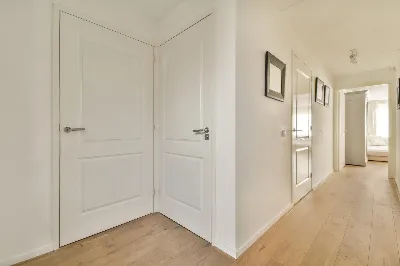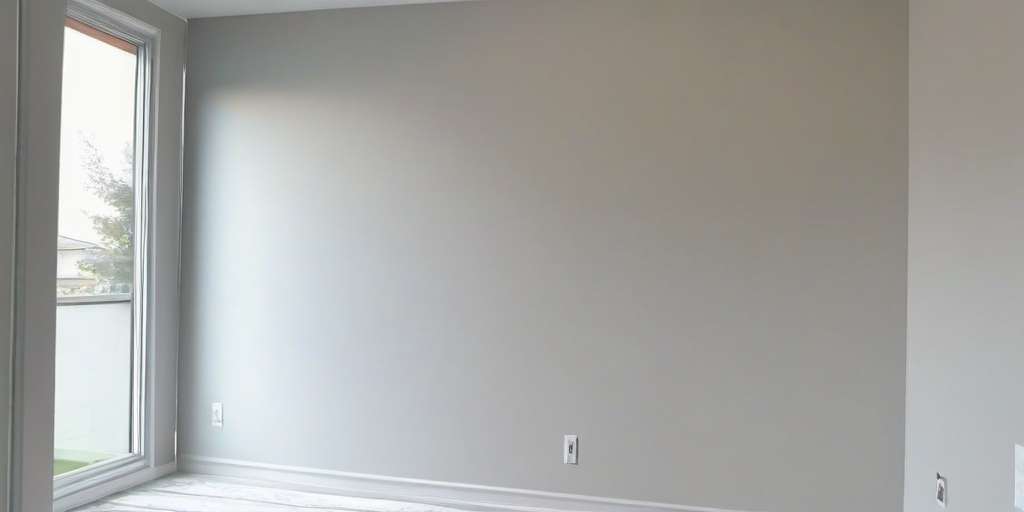
Drywall: From Historical Beginnings to Modern Techniques
Drywall, also known as gypsum board or sheetrock, is a key material in modern construction. It is made from calcium sulfate dihydrate and is widely used for walls and ceilings. The development of drywall began in the late 19th century and has evolved significantly over the years. It is favored for its ease of installation, efficiency, and versatility.

History and Evolution of Drywall
Drywall has a rich history that dates back to the late 19th century and has undergone significant evolution over the years, leading to its widespread use in modern construction.
Invention of Sackett Board
The Sackett Board, invented in 1894, marked the starting point of drywall development. This early version laid the groundwork for the gypsum board we know today.
Development of Gypsum Board
By the 1910s and 1930s, gypsum board, or drywall, had evolved with advancements in material composition and production processes. These developments enhanced its strength and durability.
Advances in Fire Resistance and Efficiency
Over time, drywall underwent improvements in fire resistance and installation efficiency, making it a preferred choice in construction. These advancements contributed to its widespread adoption in America by the mid-20th century.
Materials and Composition
In the construction industry, drywall is a staple material known for its versatility and ease of installation. Understanding the materials and composition of drywall is essential for ensuring the quality and durability of interior walls and ceilings.
Components of Drywall
- Sulfate of Calcium Dihydrate (Gypsum)
- Additives for Strength and Flexibility
Types of Additives
Mold Resistance
Mold-resistant additives are incorporated into drywall to prevent the growth of mold and mildew, ensuring a healthier indoor environment.
Fire Resistance
Fire-resistant additives enhance the ability of drywall to withstand high temperatures, making it a crucial element in building safety.
Water Resistance
Water-resistant additives protect drywall from moisture damage, particularly in areas prone to humidity or water exposure.
Paper and Fiber Glass Reinforcement
The outer layers of drywall consist of paper or fiberglass, providing structural support and a smooth surface for finishing.
Manufacture of Drywall Panels
The process of manufacturing drywall panels involves several key steps to create a durable and versatile construction material.
Process of Heating and Rehydration
- Heating the gypsum to remove water content
- Rehydrating the gypsum to form the hemihydrate compound
- Key step in creating the base material for drywall panels
Mixing with Fibers and Additives
After the gypsum is prepared, it is mixed with various fibers and additives to enhance its properties.
- Addition of compounds to improve mold resistance
- Incorporation of fire-resistant elements for safety
- Blending with water-resistant additives for durability
Panel Formation and Drying
The moist gypsum mixture is sandwiched between layers of paper or fiberglass, forming the basis for drywall panels.
- Formation of the panel through a continuous process
- Drying the panels in controlled conditions for strength
- Ensuring uniform thickness and quality during manufacturing
Drywall Specifications and Standards
Sizes and Thicknesses
Drywall panels come in various sizes and thicknesses to accommodate different construction needs. Common sizes include 4×8 feet, 4×12 feet, and 4×16 feet, with thicknesses ranging from 1/4 inch to 5/8 inch. Thicker panels are often used for added durability and soundproofing.
Regional Standards
United States
In the United States, drywall standards are set by organizations like the ASTM International and the Gypsum Association. These standards outline specifications for panel sizes, thicknesses, and performance characteristics. Additionally, building codes at the state and local levels dictate the use of drywall in construction projects.
Canada
Canada follows similar standards to the United States, with organizations like the Canadian General Standards Board (CGSB) establishing guidelines for drywall manufacturing and installation. Canadian building codes mandate the use of fire-resistant drywall in specific applications to ensure safety and compliance.
Europe
European countries have their own set of standards for drywall production and installation. Organizations like the European Gypsum Association (Eurogypsum) provide guidelines for product quality, environmental sustainability, and fire safety. These standards ensure consistency and quality across the European construction industry.
Australia and New Zealand
In Australia and New Zealand, drywall standards are regulated by industry bodies such as the Standards Australia and the Joint Accreditation System of Australia and New Zealand (JAS-ANZ). These standards cover aspects like panel dimensions, fire resistance ratings, and environmental impact assessments to ensure safe and efficient use of drywall in construction projects.
Drywall Installation Techniques
Tools Required
- Cutting Tools
- Measuring Tools
- Joint Compounds and Reinforcement
Step-by-Step Installation
Before beginning the drywall installation process, it is essential to ensure you have the necessary tools and materials. Follow these steps for a successful installation:
Preparing the Surface
Prior to installing the drywall panels, make sure the surface is clean, level, and free of any debris. Proper surface preparation is key to a smooth finish.
Cutting and Fitting Panels
Measure and cut the drywall panels to fit the dimensions of the space. Use a utility knife and T-square for precise cuts. Ensure a snug fit without any gaps.
Securing Panels to Studs
Once the panels are cut to size, use drywall screws to attach them to the wall studs. Start at the top and work your way down, ensuring each panel is securely fastened.
Repairing Drywall
Common Issues with Drywall
When dealing with drywall, there are common issues that may arise, including:
- Cracks and Holes: Small cracks and holes can be a common occurrence in drywall, often caused by settling or impact.
- Water Damage: Water damage can weaken drywall, leading to stains, warping, or mold growth.
- Mold and Mildew: Moisture can create an environment for mold and mildew to grow on drywall surfaces.
Drywall Repair Techniques
There are various techniques for repairing drywall, including:
- Patching Small Holes: Small holes in drywall can be easily patched using spackling compound and sanding for a smooth finish.
- Repairing Large Holes: For larger holes, a drywall patch or replacement section may be necessary, followed by taping, mudding, and sanding.
- Fixing Water Damage: Water-damaged drywall should be dried thoroughly, treated for mold if needed, and replaced if extensively damaged.
Drywall Anchors and Their Uses
Types of Drywall Anchors
- Expansion Anchors
- Toggle Bolts
- Self-Drilling Anchors
Choosing the Right Anchor
When it comes to selecting the proper drywall anchor for your project, it’s essential to consider factors such as the weight of the object being hung and the type of wall material.
Each type of anchor has its strengths and best uses, so it’s important to match the anchor to the specific requirements of your installation.
Installation of Drywall Anchors
Proper installation of drywall anchors is crucial to ensure that your objects are securely attached to the wall. Whether you are using expansion anchors, toggle bolts, or self-drilling anchors, following the correct installation process is key.
Be sure to drill the holes to the appropriate size, insert the anchors securely, and tighten them properly to create a strong base for hanging objects.
Advantages and Applications of Drywall
Drywall offers numerous benefits for construction projects, from cost efficiency to ease of installation and versatility in applications.
Benefits of Using Drywall
- Cost Efficiency: Drywall is a cost-effective option for interior finishing, providing a durable and aesthetic surface at a reasonable price.
- Ease of Installation: The lightweight nature of drywall panels makes them easy to handle and install, saving time and labor during construction.
- Versatility: Drywall can be used in various settings, from residential homes to commercial buildings, offering a flexible solution for different projects.
Common Applications
Residential Construction
Drywall is a staple material in residential construction, used for creating interior walls and ceilings in homes of all sizes.
Commercial Buildings
In commercial settings, drywall is widely utilized for partition walls, office spaces, and retail interiors, providing a clean and polished finish.
Renovations and Repairs
During renovations or repairs, drywall is essential for updating interior spaces, addressing damage, and enhancing the overall look and feel of a building.
Specialized Drywall Variants
Moisture-Resistant Drywall
Moisture-resistant drywall is specifically designed to withstand damp environments, such as bathrooms or kitchens. It is composed of materials that prevent moisture penetration and resist mold and mildew growth. This type of drywall is an excellent choice for areas prone to high humidity levels.
Fire-Resistant Drywall
Fire-resistant drywall is engineered to inhibit the spread of flames in case of a fire. It contains additives that provide enhanced fire protection, allowing for additional time to evacuate a building in emergency situations. This type of drywall is commonly used in commercial buildings and areas with strict fire safety regulations.
Soundproof Drywall
Soundproof drywall, also known as acoustic drywall, is designed to reduce noise transmission between rooms. It features special materials that absorb sound vibrations, minimizing sound transfer and creating a quieter indoor environment. This type of drywall is ideal for spaces where noise control is essential, such as home theaters or music studios.
Eco-Friendly Drywall Options
Eco-friendly drywall options prioritize sustainability and environmental impact. These variants may include recycled materials, low-VOC compounds, or products sourced from renewable resources. By choosing eco-friendly drywall options, builders can reduce their carbon footprint and promote green building practices.
